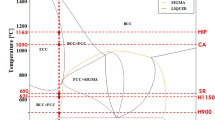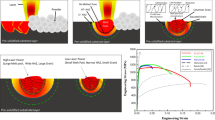Abstract
The high tensile residual stresses in the laser powder bed fusion (LPBF) manufactured H13 steel lead to severe cracks and low mechanical properties. To solve this problem, the laser shock peening (LSP) was applied to H13 steel manufactured by LPBF to eliminate tensile residual stress and improve mechanical property. The evolution mechanism of defects and residual stress during LPBF-LSP process were accounted for using the finite element method. The numerical results indicate that the compressive residual stress induced by LSP shock was beneficial for pores and cracks closure. A single shock cannot completely eliminated the tensile residual stress generated in LPBF process, and the mechanism of tensile residual stresses elimination by shock wave and rarefaction wave was proposed. The LSP process parameters of LPBF manufactured h13 steel were optimized by single point impact tests, and the effects of residual stress induced by LSP on defect, microstructure, and nano-hardness were experimentally studied. The experimental result shows that the defect closure zone depth increases with the number of laser impacts. The nano-hardness near the surface was increased by 31% than the LPBF sample after double LSP treatment. The strengthening mechanism of LSP-H13 was clarified as dislocation strengthening. This work verifies the feasibility of tensile residual stress elimination and mechanical properties improvement of the LPBF manufactured H13 steel by LSP treatment.













Similar content being viewed by others
References
Liu G, Zhang X, Chen X et al (2021) Additive manufacturing of structural materials. Mater Sci Eng R Reports 145:100596. https://doi.org/10.1016/j.mser.2020.100596
Sing SL, Huang S, Goh GD et al (2021) Emerging metallic systems for additive manufacturing: In-situ alloying and multi-metal processing in laser powder bed fusion. Prog Mater Sci 119:100795. https://doi.org/10.1016/j.pmatsci.2021.100795
Bajaj P, Hariharan A, Kini A et al (2020) Steels in additive manufacturing: a review of their microstructure and properties. Mater Sci Eng A 772:138633. https://doi.org/10.1016/j.msea.2019.138633
Li N, Huang S, Zhang G et al (2019) Progress in additive manufacturing on new materials: A review. J Mater Sci Technol 35:242–269. https://doi.org/10.1016/j.jmst.2018.09.002
Fonseca EB, Gabriel AHG, Araújo LC et al (2020) Assessment of laser power and scan speed influence on microstructural features and consolidation of AISI H13 tool steel processed by additive manufacturing. Addit Manuf 34:101250. https://doi.org/10.1016/j.addma.2020.101250
Savrai RA, Toporova DV, Bykova TM (2022) Improving the quality of AISI H13 tool steel produced by selective laser melting. Opt Laser Technol 152:108128. https://doi.org/10.1016/j.optlastec.2022.108128
Mertens R, Vrancken B, Holmstock N et al (2016) Influence of powder bed preheating on microstructure and mechanical properties of H13 tool steel SLM parts. Phys Procedia 83:882–890. https://doi.org/10.1016/j.phpro.2016.08.092
Krell J, Röttger A, Geenen K, Theisen W (2018) General investigations on processing tool steel X40CrMoV5–1 with selective laser melting. J Mater Process Technol 255:679–688. https://doi.org/10.1016/j.jmatprotec.2018.01.012
Fu J, Li H, Song X, Fu MW (2022) Multi-scale defects in powder-based additively manufactured metals and alloys. J Mater Sci Technol 122:165–199. https://doi.org/10.1016/j.jmst.2022.02.015
Tan Q, Zhang J, Sun Q et al (2020) Inoculation treatment of an additively manufactured 2024 aluminium alloy with titanium nanoparticles. Acta Mater 196:1–16. https://doi.org/10.2139/ssrn.3592041
Liu Y, Zhang J, Tan Q et al (2021) Additive manufacturing of high strength copper alloy with heterogeneous grain structure through laser powder bed fusion. Acta Mater 220:117311. https://doi.org/10.1016/j.actamat.2021.117311
Tan Q, Yin Y, Wang F et al (2022) Rationalization of brittleness and anisotropic mechanical properties of H13 steel fabricated by selective laser melting. Scr Mater 214:114645. https://doi.org/10.1016/j.scriptamat.2022.114645
Tan Q, Chang H, Yin Y et al (2022) Simultaneous enhancements of strength and ductility of a selective laser melted H13 steel through inoculation treatment. Scr Mater 219:114874. https://doi.org/10.1016/j.scriptamat.2022.114874
Du D, Haley JC, Dong A et al (2019) Influence of static magnetic field on microstructure and mechanical behavior of selective laser melted AlSi10Mg alloy. Mater Des 181:107923. https://doi.org/10.1016/j.matdes.2019.107923
Zhou H, Song C, Yang Y et al (2022) The microstructure and properties evolution of SS316L fabricated by magnetic field-assisted laser powder bed fusion. Mater Sci Eng A 845:143216. https://doi.org/10.1016/j.msea.2022.143216
Zhang M, Liu C, Shi X et al (2016) Residual stress, defects and grain morphology of Ti-6Al-4V alloy produced by ultrasonic impact treatment assisted selective laser melting. Appl Sci 6:304
Tilita G-A, Chen W, Leung CKL et al (2017) Influence of ultrasonic excitation on the mechanical characteristics of SLM 304L stainless steel. Procedia Eng 216:18–27. https://doi.org/10.1016/j.proeng.2018.02.084
Kalentics N, de Seijas MOV, Griffiths S et al (2020) 3D laser shock peening — a new method for improving fatigue properties of selective laser melted parts. Addit Manuf 33:101112. https://doi.org/10.1016/j.addma.2020.101112
Lv J, Luo K, Lu H et al (2022) Achieving high strength and ductility in selective laser melting Ti-6Al-4V alloy by laser shock peening. J Alloys Compd 899:163335. https://doi.org/10.1016/j.jallcom.2021.163335
Xin R, Lan L, Bai C et al (2022) Fatigue properties of selective laser melted Ti-6Al-4V alloy subjected to laser shock processing. J Mater Sci 57:9619–9630. https://doi.org/10.1007/s10853-022-07019-9
Maleki E, Bagherifard S, Unal O et al (2022) On the effects of laser shock peening on fatigue behavior of V-notched AlSi10Mg manufactured by laser powder bed fusion. Int J Fatigue 163:107035. https://doi.org/10.1016/j.ijfatigue.2022.107035
Zhou J, Zhou X, Li H et al (2022) In-situ laser shock peening for improved surface quality and mechanical properties of laser-directed energy-deposited AlSi10Mg alloy. Addit Manuf 60:103177. https://doi.org/10.1016/j.addma.2022.103177
Sandmann P, Keller S, Kashaev N et al (2022) Influence of laser shock peening on the residual stresses in additively manufactured 316L by Laser Powder Bed Fusion: a combined experimental–numerical study. Addit Manuf 60:103204. https://doi.org/10.1016/j.addma.2022.103204
Kalentics N, Sohrabi N, Tabasi HG et al (2019) Healing cracks in selective laser melting by 3D laser shock peening. Addit Manuf 30:100881. https://doi.org/10.1016/j.addma.2019.100881
Chen L, Gu P, Ge T et al (2022) Effect of laser shock peening on microstructure and mechanical properties of TiC strengthened Inconel 625 alloy processed by selective laser melting. Mater Sci Eng A 835:142610. https://doi.org/10.1016/j.msea.2022.142610
Zhang Y, Yang X, Wang S et al (2022) Research on tribological properties of H13 steel of shield machine hob by laser shot peening. Int J Adv Manuf Technol 119:7121–7131. https://doi.org/10.1007/s00170-021-08578-y
Sun B, Zhao J, Qiao H, Lu Y (2022) Effects of square spot size and beam quality on residual stress of 7050 aluminum alloy by laser shock peening. Mater Chem Phys 284:126023. https://doi.org/10.1016/j.matchemphys.2022.126023
Carter LN, Essa K, Attallah MM (2015) Optimisation of selective laser melting for a high temperature Ni-superalloy. Rapid Prototyp J 21:423–432. https://doi.org/10.1108/RPJ-06-2013-0063
Fabbro R, Fournier J, Ballard P et al (1990) Physical study of laser-produced plasma in confined geometry. J Appl Phys 68:775–784
Waqar S, Guo K, Sun J (2021) FEM analysis of thermal and residual stress profile in selective laser melting of 316L stainless steel. J Manuf Process 66:81–100. https://doi.org/10.1016/j.jmapro.2021.03.040
Tan Q, Liu Y, Fan Z et al (2020) Effect of processing parameters on the densification of an additively manufactured 2024 Al alloy. J Mater Sci Technol 58:34–45. https://doi.org/10.1016/j.jmst.2020.03.070
Li K, Cai Y, Yu Z, Hu J (2020) Formation mechanism of residual stress hole under different pulse durations and shock pressure distributions in Ti6Al4V alloy during laser peen texturing. Opt Laser Technol 130:106361. https://doi.org/10.1016/j.optlastec.2020.106361
Pan X, Zhou L, Wang C et al (2023) Microstructure and residual stress modulation of 7075 aluminum alloy for improving fatigue performance by laser shock peening. Int J Mach Tools Manuf 184:103979. https://doi.org/10.1016/j.ijmachtools.2022.103979
Rk G, G R, (2020) FE simulation for stress distribution and surface deformation in Ti-6Al-4V induced by interaction of multi scale laser shock peening parameters. Optik (Stuttg) 206:164280. https://doi.org/10.1016/j.ijleo.2020.164280
DebRoy T, Wei HL, Zuback JS et al (2018) Additive manufacturing of metallic components – Process, structure and properties. Prog Mater Sci 92:112–224. https://doi.org/10.1016/j.pmatsci.2017.10.001
Xiu L, Wu J, Liu Z et al (2017) Weld distortion prediction of the CFETR vacuum vessel by inherent strain theory. Fusion Eng Des 121:43–49
Oliver WC, Pharr GM (2004) Measurement of hardness and elastic modulus by instrumented indentation: advances in understanding and refinements to methodology. J Mater Res 19:3–20. https://doi.org/10.1557/jmr.2004.19.1.3
Chen CJ, Yan K, Qin L et al (2017) Effect of heat treatment on microstructure and mechanical properties of laser additively manufactured AISI H13 tool steel. J Mater Eng Perform 26:5577–5589. https://doi.org/10.1007/s11665-017-2992-0
Zhang H, Cai Z, Chi J et al (2022) Gradient microstructure evolution in laser shock peened Ti6Al4V titanium alloy. Surf Coatings Technol 437:128378. https://doi.org/10.1016/j.surfcoat.2022.128378
Author information
Authors and Affiliations
Corresponding author
Ethics declarations
Conflict of interests
The authors declare no competing interests.
Additional information
Publisher's Note
Springer Nature remains neutral with regard to jurisdictional claims in published maps and institutional affiliations.
Highlights
Clarified the cracks evolution of H13 steel manufactured by LPBF.
A in-situ SLM-LPBF numerical model is proposed to study residual stress evolution, and the mechanism of tensile residual stresses elimination by shock wave and rarefaction wave is proposed.
The LSP enhances microstructure of LPBF manufactured H13 steel, generating abundant dislocation structures.
Improving nano-hardness of LPBF manufactured H13 steel through residual stress modulation by LSP.
Supplementary Information
Below is the link to the electronic supplementary material.
Supplementary file1 (MP4 1510 KB)
Rights and permissions
Springer Nature or its licensor (e.g. a society or other partner) holds exclusive rights to this article under a publishing agreement with the author(s) or other rightsholder(s); author self-archiving of the accepted manuscript version of this article is solely governed by the terms of such publishing agreement and applicable law.
About this article
Cite this article
Guo, K., Liu, W. Improving mechanical properties of additively manufactured H13 steel through residual stress modulation by laser shock peening. Int J Adv Manuf Technol (2024). https://doi.org/10.1007/s00170-024-13558-z
Received:
Accepted:
Published:
DOI: https://doi.org/10.1007/s00170-024-13558-z




